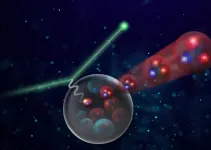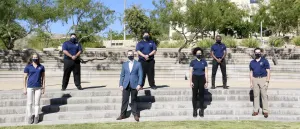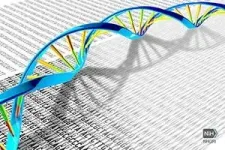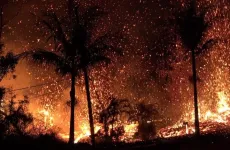(Press-News.org) While protons populate the nucleus of every atom in the universe, sometimes they can be squeezed into a smaller size and slip out of the nucleus for a romp on their own. Observing these squeezed protons may offer unique insights into the particles that build our universe.
Now, researchers hunting for these squeezed protons at the U.S. Department of Energy's Thomas Jefferson National Accelerator Facility have come up empty handed, suggesting there's more to the phenomenon than first thought. The result was recently published in Physical Review Letters.
"We were looking to squeeze the proton such that its quarks are in a small-size configuration. And that's a pretty tough thing to do," said Holly Szumila-Vance, a Jefferson Lab staff scientist.
Protons are made of three quarks bound up by the strong force. In an ordinary proton, the strong force is so strong that it leaks out, making the proton stick to other protons and neutrons around it in the nucleus. That's according to quantum chromodynamics, or QCD, the theory that describes how quarks and the strong force interact. In QCD, the strong force is also referred to as the color force.
However, QCD also predicts that the proton can be squeezed such that the quarks become more tightly knit - essentially wrapping themselves up so tightly in the color force that it no longer leaks out of the proton. When that happens, the proton no longer sticks to other particles and can move freely through the nucleus. This phenomenon is called "color transparency," since the proton has become invisible to the color force of the particles around it.
"It's a fundamental prediction of quantum chromodynamics, the theory that describes these particles," Szumila-Vance explained.
An earlier experiment showed color transparency in simpler particles made of quarks called pions. Where protons have three quarks, pions have just two. In addition, another experiment conducted with protons had also suggested that protons also may exhibit color transparency at energies well within reach of the recently upgraded facility at Jefferson Lab.
"We expected to find the protons squeezed just like the pions," said Dipangkar Dutta, a professor at Mississippi State University and a spokesperson for the experiment. "But we went to higher and higher energies and are still not finding them."
The experiment was one of the first to run in the Continuous Electron Beam Accelerator Facility, a DOE Office of Science User Facility, following its 12 GeV upgrade. In the experiment, the nuclear physicists directed high-energy electrons from CEBAF into the nuclei of carbon atoms. They then measured the outgoing electrons and any protons that came out.
"This was an exciting experiment to be a part of. It was the first experiment to run in Experimental Hall C after we upgraded the hall for 12 GeV running," said Szumila-Vance. "These were the highest-momentum protons measured at Jefferson Lab, and the highest-momentum protons ever produced by electron scattering."
"At the energies we are probing, the proton is usually decimated, and you're looking at the debris of the proton," Dutta explained. "But in our case, we want the proton to stay a proton, and the only way that that can happen is if the quarks kind of squeeze together, hold each other much more tightly so that they can escape together from the nucleus."
While the nuclear physicists observed several thousand protons in the experiment, they did not find the tell-tale signs of color transparency in the new data.
"I think this tells us that the proton is more complicated than we expected," said Szumila-Vance. "This is a fundamental prediction of the theory. We know that it has to exist at some high energy, but just don't yet know where that will happen."
The researchers said the next step is to better understand the phenomenon in simpler particles where it has already been observed, so that improved predictions can be made for more complex particles, such as protons.
INFORMATION:
Ninety nuclear physicists representing 27 institutions contributed to this experiment, including two graduate students: Deepak Bhetuwal from Mississippi State University and John Matter from the University of Virginia.
Further Reading
Peer-reviewed scientific paper: Ruling out color transparency in quasielastic 12C(e,e'p) up to Q2 of 14.2 (GeV/c)2: https://journals.aps.org/prl/abstract/10.1103/PhysRevLett.126.082301
Skinny Pions Sail Through Nucleus: https://www.jlab.org/news/ontarget/target-march-2008#pions
A University of Oklahoma-led study published in 2020 revealed that both area and plant growth of paddy rice is significantly related to the spatial-temporal dynamics of atmospheric methane concentration in monsoon Asia, where 87% of the world's paddy rice fields are situated. Now, the same international research team has released a follow-up discussion paper in the journal Nature Communications. In this paper, the team identifies the limits and insufficiency of the major greenhouse emission database (EDGAR) in estimating paddy rice methane emissions.
"Methane emission from paddy ...
EL PASO, Texas - A study by physiology researchers at The University of Texas at El Paso found that El Paso's stay-at-home ordinance due to the COVID-19 pandemic had positive effects on the health and well-being of the region's residents.
Despite a shutdown of gyms and movement restrictions on non-essential activities, residents increased their fitness activity and closely monitored their food and nutrition intake, said Cory M. Smith, Ph.D., assistant professor of kinesiology in UTEP's College of Health Sciences and the study's principal investigator.
More than 1,300 El Paso and ...
Researchers at the University of Maryland School of Medicine (UMSOM) co-authored a study, published today in the journal Science, that details the sequencing of 64 full human genomes. This reference data includes individuals from around the world and better captures the genetic diversity of the human species. Among other applications, the work will enable population-specific studies on genetic predispositions to human diseases as well as the discovery of more complex forms of genetic variation.
Twenty years ago this month, the International Human Genome Sequencing Consortium announced the first draft of the human genome reference sequence. The Human Genome Project, as it was called, required 11 years of work and involved more than 1000 ...
Psychologists have long found that people behave differently than when they learn of peers' actions. A new study by computer scientists found that when individuals in an experiment about autonomous vehicles were informed that their peers were more likely to sacrifice their own safety to program their vehicle to hit a wall rather than hit pedestrians who were at risk, the percentage of individuals willing to sacrifice their own safety increased by approximately two-thirds.
As computer scientists train machines to act as people's agents in all sorts of situations, the study's authors indicate that the social component of decision-making is often overlooked. This could be of great consequence, note the paper's authors who show that the trolly problem -long shown to be ...
States regularly use administrative records, such as motor-vehicle data, in determining whether people have moved to prune their voter rolls. A Yale-led study of this process in Wisconsin shows that a significant percentage of registered voters are incorrectly identified as having changed addresses, potentially endangering their right to vote.
The study, published in the journal Science Advances, found that at least 4% of people listed as suspected "movers" cast ballots in 2018 elections using addresses that were wrongly flagged as out of date. Minority voters were twice as likely as white voters to cast their ...
The COVID-19 virus holds some mysteries. Scientists remain in the dark on aspects of how it fuses and enters the host cell; how it assembles itself; and how it buds off the host cell.
Computational modeling combined with experimental data provides insights into these behaviors. But modeling over meaningful timescales of the pandemic-causing SARS-CoV-2 virus has so far been limited to just its pieces like the spike protein, a target for the current round of vaccines.
A new multiscale coarse-grained model of the complete SARS-CoV-2 virion, its core genetic material and virion shell, has been developed for the first time using supercomputers. The model offers ...
Litter is not only a problem on Earth. According to NASA, there are currently millions of pieces of space junk in the range of altitudes from 200 to 2,000 kilometers above the Earth's surface, which is known as low Earth orbit (LEO). Most of the junk is comprised of objects created by humans, like pieces of old spacecraft or defunct satellites. This space debris can reach speeds of up to 18,000 miles per hour, posing a major danger to the 2,612 satellites that currently operate at LEO. Without effective tools for tracking space debris, parts of LEO may even become too hazardous for satellites.
In a paper publishing today in the SIAM Journal on Imaging Sciences, Matan Leibovich (New York University), George Papanicolaou (Stanford University), and Chrysoula Tsogka (University of California, ...
The unprecedented cost of the 2018 Kilauea eruption in Hawai'i reflects the intersection of distinct physical and social phenomena: infrequent, highly destructive eruptions, and atypically high population growth, according to a new study published in Nature Communications and led by University of Hawai'i at Mānoa researchers.
It has long been recognized that areas in Puna, Hawai'i, are at high risk from lava flows. This ensured that land values were lower in Puna--which lies within the three highest risk lava hazard zones 1, 2 and 3--which actively promoted rapid population ...
Our body consists of 100 trillion cells that communicate with each other, receive signals from the outside world and react to them. A central role in this communication network is attributed to receiver proteins, called receptors, which are anchored at the cell membrane. There, they receive and transmit signals to the inside of the cell, where a cell reaction is triggered.
In humans, G protein-coupled receptors (GPC receptors) represent the largest group of these receptor molecules, with around 700 different types. The research of the Frankfurt and Leipzig scientists focused on a GPC receptor that serves as a receptor for the ...
Timothy Callaghan, PhD, and Alva Ferdinand, DrPH, JD, from the Southwest Rural Health Research Center at Texas A&M University School of Public Health, joined colleagues in the first national study of how often people in urban and rural areas in the United States follow COVID-19 guidelines. These include public health best practices like wearing masks in public, sanitizing homes and work areas, maintaining physical distancing, working from home and avoiding dining in restaurants or bars.
The research team used a survey of 5,009 U.S. adults that closely matched the makeup of the country's population as a whole. The survey asked how often participants followed COVID-19 prevention recommendations and collected data on political ideology, perceived risk ...




